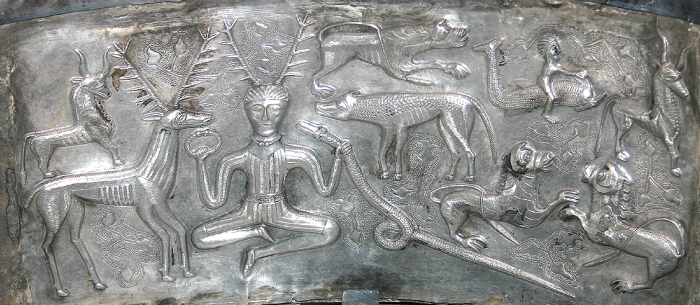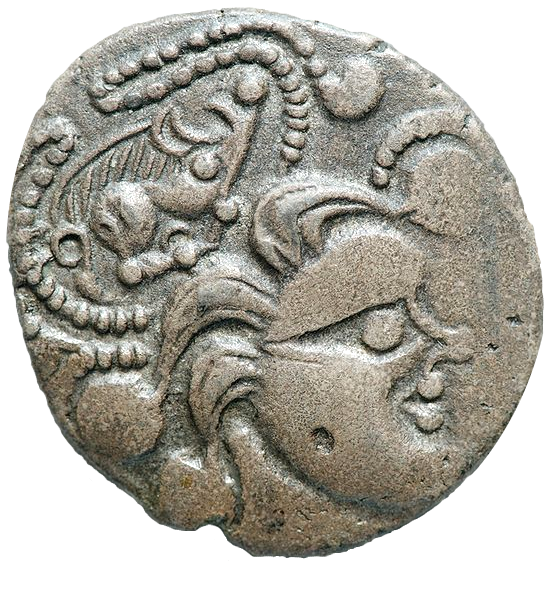Gaulish reconstructionists more resistant to Gallo-Roman syncretism will want to look into the possibility of reconstructing a Gaulish tradition of essentially pre-Roman, Celtic character (on the understanding that Celticness does not rule out significant links with the Hellenized and Etruscan worlds). One casualty of this approach is, in all likelihood, being able to follow the tradition of a specific nation or ‘tribe’ (unless that be the Salluvii of Provence). The resulting pan-Gaulish religious synthesis must therefore necessarily be somewhat artificial.

Among the oldest testimonies to Celtic religion, one might mention the rock carvings of the Val Camonica, one of which represents the antlered god who would later be called Cernunnos in Roman Paris. Next comes the Gundestrup Cauldon: that crucial, paradoxical and mysterious artifact of ancient Celtic religion, probably commissioned of Thracian artisans by Balkan Celts, but discovered in Denmark. Other pre-Roman representations whose religious nature is more or less certain include crude sculptures in the south of France and in the Rhineland (such as the Mars images of the lower Rhône or the Holzerlingen stone) as well as some rare works in wood. Such items give us an idea of the symbolism of Celtic religion (the antlered god, the ram-headed serpent, the god holding a wheel, and so on).[1]
There is also the archaeological evidence of Belgic sanctuaries such as those at Ribemont-sur-Ancre or Gournay-sur-Aronde, as well as semi-Hellenized temples such as at Glanum (Saint-Rémy-de-Provence) or Entremont (near Aix-en-Provence). These prove for one thing that the Celts, both north and south, clearly demarcated sacred spaces, whether by a ditch or by a wall; that sanctuaries were often at a distance from populated places; that people deposited coins, luxury items and the like at such sanctuaries, without anyone else interfering with them (this confirms a comment of Posidonius on the subject); that human skulls regularly featured in such places’ décor; and that the bodies of certain sacrificial animals were left there to rot where they lay. What we have here is a heritage that is rather difficult to square with a society like our own, which is largely urbanized and concerned with human rights. It would not be hard to incorporate certain elements into one’s private shrine (but up till now no direct attestation of pre-Roman domestic worship has, I believe, been uncovered).[2]

The bulk of the Greek and Latin texts dealing with druids (and sometimes with their colleagues, the vates and bards) comes from the pre-Roman period. At that time, they constituted a privileged class that acted as astronomers, philosophers, religious counsellors, political arbiters and experts in metaphysics. (To be sure, the repeated efforts of emperors to suppress the druidic school prove that, in some form or another, it survived the conquest. However, those that we find in Tacitus, for example, are no longer anything more than prophesying magicians: an interesting example of a subaltern religious phenomenon, but nothing extraordinary in the Roman world. The post-conquest ‘druids’ have lost their unique quality as noble philosophers, expert in astronomy and other branches of knowledge—in short, everything that made them druids.) If it is even possible today to attain the rank of druid, candidates must at any rate devote long studies to ancient knowledge, notably relating to astronomy; reflect deeply on the nature of matter and the place of humankind in the universe; and, if possible, teach such knowledge to others.[3]
Celtic coins are by no means silent on religious matters. They exemplify the Gaulish production of Hellenistic images of this god or that, most notably Apollo, Jupiter and Hercules. They also bear other religious symbols, such as solar wheels.
Finally, religious material from the Julio-Claudian era might also be included in a Celtic reconstructionism, for that was a time when most Gauls still preserved their Celtic culture largely intact under Roman or Romanized masters. A key document from this period is the Column of the Parisian Boatmen, which attests to an early syncretism characterized by rather jarring juxtapositions of Roman and Gaulish elements. Celtic enthusiasts might wish to pay most of their attention to the ‘Celtic’ panels of the Column; but it should be remembered that the monument as a whole was dedicated to Tiberius Augustus and to Jupiter Optimus Maximus, the earthly and heavenly protectors of Rome. Among documents from this period, we can add the stone dedicated to Mercury at Trier depicting Esus, along with most depictions of the antlered god, the god with a hammer, the three-headed god, and Jupiter holding a wheel. The great relief from Rheims representing the antlered god in the company of Mercury and Apollo is fairly typical of this first wave of syncretism. (While distinctively Gaulish, columns featuring an equestrian Jupiter are generally of a later date.) The Coligny calendar probably dates from the same period.
The bulk of surviving Gaulish texts were also likely to have been composed under the Roman Empire. The rest were written earlier, particularly those written in the Greek or even Etruscan alphabets; some go back many centuries before the Common Era. Overall, Gaulish texts are not very numerous, most are short, and their interpretation is sometimes very difficult. Nevertheless, they definitively attest the Celtic names of many gods and goddesses:[4]
What we have here are the outlines of a ‘pantheon’ (admittedly incomplete, drawn from disparate sources, and comprised in large part of little-known gods), some precedents to adapt in terms of ritual (and major adaptations they do require), hints about where to begin one’s scholarly or philosophical studies, and a certain visual æsthetic.
What, then, does this purely ‘Celtic’ picture need to leave out? First off, divine couples such as Mercury and Rosmerta, Apollo Grannus and Ðirona, Mars and Litavis, Mars Loucetius and Nemetona, Lenus Mars and Ancamna, Apollo Borvo and Damona ... all of whom are wholly absent from Gaulish texts. Next, the rich symbolism of the Jupiter–giant columns, as previously mentioned. Plus everything we know about the mythology and philosophy that the Gauls would have received from the Mediterranean world (for example foundation myths linking Gaulish towns to Hercules, the Platonism that was in vogue in Gaul, etc.). Temples of the Gallo-Roman type, namely with a regular floorplan surrounded by a porch. The federal celebration of the Gaulish provinces on the 1st of August at Condate in Lyon, dedicated to Rome and Augustus. An enormous number of gods and goddesses with Celtic names who are commemorated only in Latin (often by high-ranking citizens). The Gaulish taste for schematized decorative motifs, such as the signs of the Zodiac, the days of the week (which are also the seven planets, and therefore gods), the four seasons, the nine Muses. The worship of genii. To be sure, a religious practice founded on the Gallo-Roman period no longer has a place for druids properly speaking; but this time has other philosophers whose teachings are much better known....
My conclusion is that there is much of great value to lost in dropping the second element of the Gallo-Roman compound. By embracing the Roman inheritance, we vastly increase the base of information for our religious reconstruction. At the same time, this lets us draw nearer to the authentic practices of our forebears, who were not picky about the ethnic origin of this god or that practice. Nevertheless, I do know that emphasizing the strictly Celtic part of our patrimony is a cherished desire for many; I have no wish to rule out the possibility altogether.

